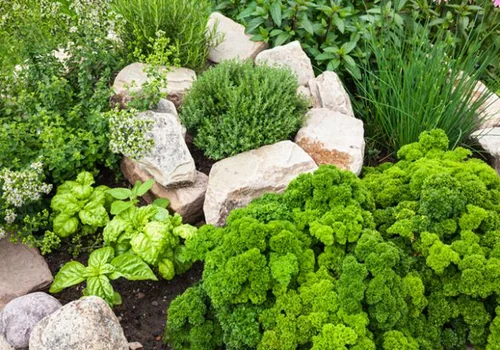Growing an herb garden has become a common practice for many gardeners. However, interplanting herbs throughout your yard and garden might be a more effective way to cultivate these beneficial plants. In this article, we will explore five reasons why spreading your herbs around your yard provides more advantages than growing them in a confined herb garden.
Benefit #1: Natural Pest Repellent
One of the most compelling reasons to interplant herbs is their natural ability to repel insect pests. Herbs like oregano, rosemary, thyme, mint, sage, basil, and garlic have strong scents that insects find unpleasant. The oils in herbs, which make them great for cooking, are also effective at keeping bugs away.
When you cluster herbs in one area, their pest-repellent properties are concentrated in that specific space. On the other hand, by spreading them around your yard, you create a perimeter of natural insect repellent, protecting your garden as a whole. In fact, many store-bought insect repellents are made from the essential oils of herbs, reinforcing their effectiveness in pest control.
Benefit #2: Control Invasive Herbs
Some herbs, such as mint, oregano, and thyme, can be highly invasive. When planted in a confined herb garden, these plants can quickly take over, leaving little room for other crops. If you’ve ever planted mint in a small bed, you know how quickly it can dominate the entire space.
By interplanting invasive herbs in different areas of your garden, particularly under fruit trees or alongside larger plants, you can control their spread while making more efficient use of your space. For example, thyme, which is shallow-rooted, pairs well with deep-rooted apple trees. The thyme spreads underneath the apple tree without competing for resources, while also acting as a natural pest deterrent.
Benefit #3: Healthier Herbs and Plants
Interplanting herbs creates a more favorable environment for their growth. Many herbs, such as rosemary, oregano, and thyme, thrive in cool, shaded areas, especially during the hot summer months. When these herbs are planted under deciduous trees like apple trees, they benefit from shade in the summer and full sunlight in the winter, as the trees lose their leaves.

This natural cycle creates a microclimate where herbs are cooler in the summer and warmer in the winter. As a result, they experience less stress from temperature extremes and grow healthier, with fewer instances of wilting, flowering too early, or damage from frost.
Benefit #4: Ground Cover and Weed Prevention
Another major advantage of interplanting herbs is their ability to act as ground cover, preventing weeds from taking root. Herbs like thyme and oregano grow densely, suffocating any weeds that try to sprout beneath them. This natural weed barrier saves you time and effort by reducing the need for constant weeding.
For example, a well-established oregano plant can completely cover the soil in its area, preventing any weeds from germinating. When interplanted with fruit trees or other larger plants, herbs not only protect the soil from weeds but also improve space efficiency in your garden.
Benefit #5: Functional Landscaping
Herbs can also serve a decorative and functional role in your landscaping. For example, herbs like rosemary and lavender can be used as foundational plantings around your home, especially in areas with limited sunlight. These evergreen herbs not only thrive in shady spots but also provide year-round greenery and a reliable source of fresh herbs for your kitchen.
In addition, the heat generated by your home can protect cold-hardy herbs from freezing during the winter months, making them ideal for planting near walls or in shaded corners of your garden. This approach allows you to make the most of every available space while enjoying the benefits of fresh herbs year-round.
How to Plant Herbs Strategically
To maximize the benefits of interplanting herbs, consider the specific needs of each herb and the plants around them. For example, invasive herbs like mint and oregano should be planted in areas where they can spread without causing harm, such as under fruit trees. Non-invasive herbs like basil, cilantro, and parsley can be interplanted among vegetables to create a pest-resistant barrier.
By carefully planning where you place your herbs, you can ensure that they work in harmony with the rest of your garden. The result will be a healthier, more efficient garden that requires less maintenance and provides a constant supply of fresh herbs for your cooking needs.
Frequently Asked Questions (FAQs)
- Can I plant herbs in containers instead of directly in the garden?
Yes, many herbs grow well in containers, which can also help control their spread. However, interplanting herbs directly in the garden provides additional benefits like natural pest control and weed prevention. - Which herbs are the most invasive?
Mint, oregano, and thyme are known for being invasive. It’s important to plant these herbs in areas where they won’t overrun other plants. - Can interplanting herbs improve the health of my other plants?
Yes, many herbs repel pests and create a favorable microclimate, which can improve the overall health of your garden. - How do herbs help prevent weeds?
Herbs like thyme and oregano grow densely, acting as natural ground cover that prevents weed seeds from germinating. - What are the best herbs to plant in shady areas?
Rosemary, thyme, and lavender are cold-hardy herbs that thrive in shady areas, making them ideal for planting near walls or under trees. - Do herbs need a lot of sunlight?
While some herbs prefer full sun, many can tolerate partial shade, especially when interplanted with taller plants or trees. - How do I know if an herb is invasive?
Research the growing habits of each herb before planting. Herbs that spread quickly or have deep root systems tend to be invasive.




